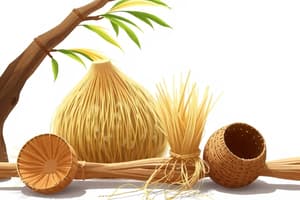Podcast
Questions and Answers
What is another name for abaca?
What is another name for abaca?
- Tropical cotton
- Asian jute
- Philippine banana (correct)
- Manila tree
How are abaca fibers extracted?
How are abaca fibers extracted?
- From the flowers of the plant
- From the leaves of the plant
- From the roots of the plant
- From the trunk and sheaths of the plant (correct)
Which industry uses abaca fibers as reinforcement materials?
Which industry uses abaca fibers as reinforcement materials?
- Textile industry
- Steel industry
- Automotive industry (correct)
- Pharmaceutical industry
What is the first step in abaca harvesting during the flowering season?
What is the first step in abaca harvesting during the flowering season?
Why is understanding crop harvesting methods crucial for maintaining food security?
Why is understanding crop harvesting methods crucial for maintaining food security?
How are recent advancements changing abaca harvesting processes?
How are recent advancements changing abaca harvesting processes?
What is the purpose of 'blanking' in abaca cultivation?
What is the purpose of 'blanking' in abaca cultivation?
When is selective harvesting typically carried out in abaca cultivation?
When is selective harvesting typically carried out in abaca cultivation?
What is the purpose of pruning in abaca cultivation?
What is the purpose of pruning in abaca cultivation?
How are fiber bundles separated after boiling the abaca stalks in water?
How are fiber bundles separated after boiling the abaca stalks in water?
What is a critical aspect of post-harvest operations in abaca cultivation?
What is a critical aspect of post-harvest operations in abaca cultivation?
Why is understanding abaca harvesting methods essential?
Why is understanding abaca harvesting methods essential?
Flashcards are hidden until you start studying
Study Notes
Crop Harvesting Methods: An In-Depth Look into Abaca Processes
Crops are essential food sources across the globe, providing vital nutrition and income opportunities for people worldwide. Understanding how crops are harvested is crucial for maintaining food security and supporting agribusinesses. In this article, we delve deeper into various crop harvesting methods, with a focus on abaca, one of the world's most resilient natural fiber plants.
Overview of Abaca
Abaca, also known as Manila hemp or banana hemp, is a tropical plant native to Southeast Asia, specifically the Philippines. This versatile plant has been cultivated for centuries due to its high adaptability to different soil types and climates. Its fibers are extracted from the trunk and sheaths of the plant, which are then processed into paper products or used as reinforcement materials in composites, such as automotive parts, lightweight panels, and wind turbine blades.
Harvesting Processes for Abaca
Harvesting abaca involves several key steps designed to maximize yield while minimizing damage to the plant structures needed for future growth. These processes are primarily manual, although recent advancements have introduced some mechanical aids to improve efficiency and reduce labor costs.
Preparation Phase
During the flowering season, the first step in abaca harvesting is to remove all flowers from the crop. This process, called "blanking," prevents seeds from forming and ensures the plant directs energy to producing new stalks rather than reproducing. It is typically carried out when the inflorescence starts to emerge or before it opens, as this is when maximum yields can be achieved without compromising subsequent harvests.
Selective Harvesting and Pruning
Selective harvesting is employed to ensure only mature, healthy stalks are cut, ensuring they can produce the highest quality fiber possible. This method allows farmers to take advantage of the abundance of leaf tissue around the harvest site, reducing the stress caused by cutting down the entire plant at once. After selectively removing the desirable stalks, pruning is performed to maintain optimal shape and structure of the remaining plants.
Fiber Extraction
Once the stalks are cut, they are stripped of their leaves and boiled in water to soften the pithy material within the stalks, making them easier to separate from the outer layers. After removal of the softer inner tissues, the fiber bundles are mechanically separated using a hammer mill, rotary drum, or other similar machinery. The resulting fiber strands are then washed, bleached, and dried, ready for processing into various end products.
Post-harvest Operations
Post-harvest operations involve cleaning and grading the raw fibers according to length and strength requirements for specific applications. Baling is another critical aspect, as the baled fiber must remain moisture free and well protected during storage and transportation. Typical bales weigh between 38 kg (84 lb) and 45 kg (100 lb), depending on the balance between desired product properties and logistical constraints.
In conclusion, understanding the intricacies behind abaca harvesting methods is essential for optimizing plant yields and ensuring sustainable production of this valuable plant species. Continued innovation in technologies and techniques will further enhance our ability to efficiently grow and harvest crops like abaca, contributing significantly to global agriculture and industry sectors.
Studying That Suits You
Use AI to generate personalized quizzes and flashcards to suit your learning preferences.




